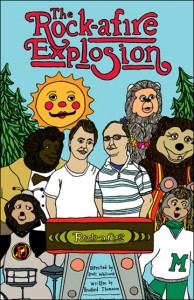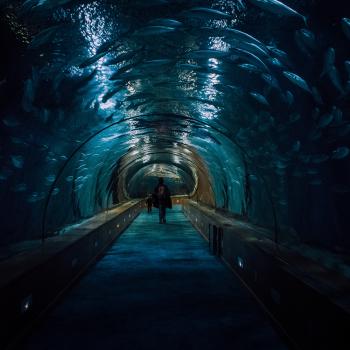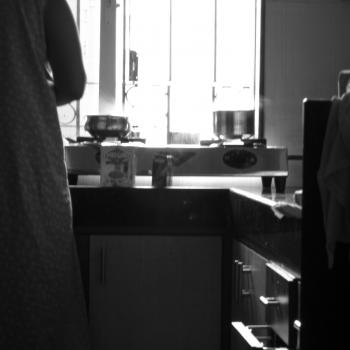 Pay no attention to the man—or rather, the band—behind the curtain.
Pay no attention to the man—or rather, the band—behind the curtain.
Like Dorothy and her beloved band of Oz oddballs, Chris Thrash wondered what the curtain concealed. As a child in the ‘80s, Thrash frequented Showbiz Pizza Place and found himself fascinated by the Rock-afire Explosion, the franchise’s band of animatronic animals.
Parents probably saw Showbiz’s mechanical musicians as pricey parlor tricks in a restaurant where pandemonium was more plentiful than pizza. To Thrash, however, they were wonders to behold.
Once, after the band finished performing and the curtains closed, Thrash peered behind them. There, he beheld the band in a state of suspended animation, staring at him.
Thrash’s obsession with Showbiz Pizza Place’s house act is chronicled with care in The Rock-afire Explosion, a 2008 documentary directed by Brett Whitcomb and Bradford Thomason. Thrash, now in his thirties, is an unassuming, soft-spoken fellow with a southern drawl. His love of the Rock-afire Explosion somehow seems incongruent with his mild mien.
Upon viewing this film, it occurred to me that Showbiz Pizza Place—the pizza franchise that later became Chuck E. Cheese’s—was more like a temple than a restaurant. On the stage, the members of the Rock-afire Explosion commanded the worship of children who could not resist the spellbinding allure of singing animals. Elsewhere, those children gave their gilded tokens to so many games, and their offerings were met with blessings in the form of tickets that could be exchanged for prizes.
When Chris Thrash peered behind the curtain then, he was encroaching upon something like sacred territory. He was looking upon the holy of holies.
As a child, my parents took me to Showbiz, too. While Thrash’s favorite band member is Dook Larue, the drumming dog, my favorite character remains Fatz Geronimo, the silverback gorilla in the golden jacket and bowtie who rivaled the Killer on the keyboard.
My parents say I often imitated Fatz when I looked in the mirror as a four-year-old—raising and lowering my eyebrows repeatedly like Showbiz’s programmable primate. Somewhere along the way, through the provision of the gaming gods (and the probable plundering of my parents’ pockets), I won a Fatz Geronimo doll. That doll would remain in my possession longer than Fatz would remain on stage.
The story of the downfall of Showbiz could easily be titled Of Mice and Men and Men in Mice Costumes. I say that because, in 1990, a mouse profaned the temple.
Instead of shooing it from the premises, the owners of the company put its name in lights. Showbiz Pizza Place became Chuck E. Cheese’s, and the members of the Rock-afire Explosion were replaced with Munch’s Make Believe Band.
To this day, I find it ironic that the owners of an eating establishment would choose as its mascot a creature most often associated with failed health inspections.
When the Rock-afire Explosion disappeared from the showroom stage, so did the magic that moved millions of children. But Chris Thrash is able to treasure the Rock-afire Explosion in the present because of someone else whose story is chronicled in the documentary.
The filmmakers peer behind a curtain of their own, turning their cameras upon inventor Aaron Fechter, who created the Rock-afire Explosion. His Orlando, Florida-based company, Creative Engineering, Inc., developed and built Rock-afire Explosions for hundreds of Showbiz Pizza Places across America in the early ‘80s.
Keeping such a colossal creative department on its payroll proved unsustainable for Showbiz. The company decided to dissolve their relationship with Creative Engineering, and requested that Fechter relinquish the rights to the Rock-afire Explosion without offering financial compensation.
Fechter refused, and his creations were expelled from the franchise.
At the peak of Creative Engineering’s partnership with Showbiz Pizza Place, Fechter employed over 300 people. As of the film’s release, he was the company’s sole employee.
Fechter remains in the building where his workforce once brought hundreds of Fatz Geronimo’s to life. The interior is largely the same as it was in the ‘80s. But workstations sit vacant. Motionless animatronic characters stare—some with sagging visages.
In his longing for the magic that animated his childhood, Chris Thrash traced the Rock-afire Explosion to its source. For the next two years, he worked tirelessly to save money so he could purchase one of the last two remaining bands from Fechter.
The band Thrash purchased had been sitting, unopened since it was sealed in 1983, in storage at Creative Engineering. It was as if it had been waiting for him—a piece of childhood, perfectly preserved—since he was a boy.
Thrash set up his own Rock-afire Explosion in a building behind his house, and began programming the band to perform contemporary songs shortly thereafter. After filming the Rock-afire Explosion’s performances and posting them on YouTube, his videos attracted nostalgic multitudes.
Thrash’s story offers an answer to the corporate equivalent of the question posed in Job 14:14: If a franchise dies, will it live again?
The plight of this pizza franchise and its rebirth through fans like Chris Thrash reminds me of the destruction of the Israelites’ temple and the Babylonian Captivity. For the Israelites, the worship of Yahweh was a corporate act that took place in the temple, where God’s presence dwelt. When they were exiled from their homeland, their temple in ruins, the Israelites were lost where worship was concerned.
When Chris Thrash established a new dwelling place for the Rock-afire Explosion, he did so because Showbiz Pizza Place had been plundered by corporate conquerors. Like the prophet Daniel during the Babylonian exile, who faced Jerusalem and worshipped God in solitude when corporate worship was no longer possible, Thrash preserved that which was sacred from his childhood the only way he knew how—alone, in the building behind his house.
Temples can be torn down or overrun by mice. Buildings are always vulnerable to destruction. The temple of the human heart, however, is not so easily plundered.












